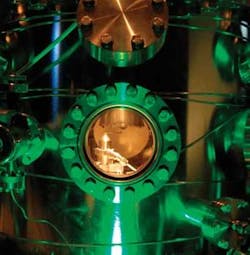ATTOSECOND METROLOGY: Attosecond electron measurement probes ultrahigh-speed electronics

Understanding the motions of electrons inside solids is the basis for future technological developments in computing speed, ultrahigh-speed communications, and remote surgery, among other possibilities. Such advances depend on detection and measurement of the atomic-scale motion of electrons, which take mere attoseconds to travel from atom to atom in a solid (1 attosecond = 10-18 s).
In April, physicists announced the attosecond-scale real-time measurement of the electron tunneling speed in neon gas using ultrashort light-pulse generation and control (see www.laserfocusworld.com/articles/294633). Now, the attosecond envelope has again expanded with the measurement of the electron transport in a condensed-matter system-the first of its kind in a solid, according to an international research team led by Ferenc Krausz, professor of physics at the Ludwig Maximillians University in Munich, and director of the Max-Planck-Institut für Quantenoptik (Garching, Germany).1
Measuring photoelectron wave packets in condensed matter can be more complicated than single-atom setups because electrons are released from energy bands containing many distinct states. The researchers chose to probe tungsten, which features localized 4f core states that are deeply bound and fully populated, meaning the emission is less complicated.
Using a 400 μJ Ti:sapphire laser system, the Max-Planck team focused 300-attosecond extreme-ultraviolet (EUV) pulses onto the (110) surface of a tungsten single crystal to trigger photoemission. A coincident, waveform-controlled near-infrared pulse at 750 nm probed the freed electrons of two types: loosely bound electrons responsible for conduction and tightly bound 4f electrons from the cores of the tungsten atoms.
An attosecond transient recorder used in previous gas-phase experiments showed that the conduction-band atoms were emitted approximately 110 as before the localized 4f core electrons, even though the emission is stimulated simultaneously by the same EUV pulse. The tiny delay between the emission of the two electrons indicates that the excited conduction electrons travel nearly twice as fast as the excited core electrons over a distance of several atomic layers inside the tungsten crystal.
Such a demonstration sheds new light on electronic charge transport across surfaces and in condensed matter. “The major significance of the measurement lies not so much in the acquisition of some revolutionary new finding,” says Krausz, “but more in the demonstration of the feasibility of observing electron transport dynamics across atomic layers in a solid in real time.”
Measuring the time required for an electron to travel between neighboring atoms represents perhaps the smallest possible length scale for electronic processes like channeling and switching signals. “This technical capability is a prerequisite for advancing electronics to its ultimate speed limits, expected to be in the petahertz regime,” says Krausz.
REFERENCES
1. A.L. Cavalieri et al., Nature 449 (7165), 1029 (Oct. 25, 2007).
About the Author
Valerie Coffey-Rosich
Contributing Editor
Valerie Coffey-Rosich is a freelance science and technology writer and editor and a contributing editor for Laser Focus World; she previously served as an Associate Technical Editor (2000-2003) and a Senior Technical Editor (2007-2008) for Laser Focus World.
Valerie holds a BS in physics from the University of Nevada, Reno, and an MA in astronomy from Boston University. She specializes in editing and writing about optics, photonics, astronomy, and physics in academic, reference, and business-to-business publications. In addition to Laser Focus World, her work has appeared online and in print for clients such as the American Institute of Physics, American Heritage Dictionary, BioPhotonics, Encyclopedia Britannica, EuroPhotonics, the Optical Society of America, Photonics Focus, Photonics Spectra, Sky & Telescope, and many others. She is based in Palm Springs, California.
